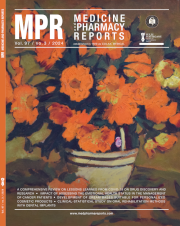Clinical-statistical study on oral rehabilitation methods using dental implants
DOI:
https://doi.org/10.15386/mpr-2772Keywords:
dental implants, prosthetic rehabilitation, bone volume reconstruction, inflammatory complicationsAbstract
Background and aims. The development of dental implantology is based on a thorough examination of the interaction of implants with surrounding tissues, as well as methods of stimulating osteogenesis around implants. Consequently, the most common approach to restore lost function in terms of function and aesthetics is now treating partially edentulous individuals with implants. The study's objective was to assess how effectively implant prosthetic treatments performed only on implants reconstruction and on implants in conjunction with abutment teeth.
Methods. A total of seven years (2016–2023) were dedicated to this study, with evaluation at one, two, three, and five years. For this analysis, MedCalc® version 12.5.0.0 (MedCalc® Software, Mariakerke, Belgium) was utilised as the medical statistics software.
Results and conclusions. When using dental implants and natural teeth abutments for prosthodontic reconstruction, the failure rates rise approximately 43 times when compared to dental implant rehabilitation; similarly, osteoporosis and diabetes mellitus increase failure rates by 32 and 20 times, respectively. Gingival inflammation is a frequent event (almost 50% frequency) observed during follow-up in patients who had prosthetic restoration using dental implants alone as well as implants and abutment teeth. For both groups, difficulties usually arise two years later.
Downloads
Published
How to Cite
Issue
Section
License
The authors are required to transfer the copyright of the published paper to the journal. This is done by agreeing to sign the Copyright Assignment Form. Whenever the case, authors are also required to send permissions to reproduce material (such as illustrations) from the copyright holder.

The papers published in the journal are licensed under a Creative Commons Attribution-NonCommercial-NoDerivatives 4.0 International License.

